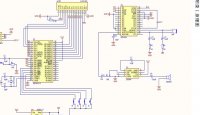基于ISD4004的个性铃声设计

基于ISD4004的个性铃声设计(论文10800字)
摘要:在数字音频技术和多媒体技术迅速发展的今天,传统的磁带语音录放系统因体积大、使用不便、放音不清晰而受到了巨大挑战。本论文设计了一个基于STC89C52单片机和语音芯片ISD4004的个性铃声存储回放系统。该系统采用STC89C52单片机为控制核心,包括电源模块、语音存储模块、显示模块、功率放大模块以及按键模块。单片机通过控制语音芯片ISD4004进行存储录音,每段录音都有其对应的地址,播放的时候单片机只需要从语音芯片中写入地址便可播放。除此以外,系统还提供了多种播放方式供用户选择。为了得到更大的声音,系统加上了一个功率放大电路以驱动扬声器。相关要设置的信息都在LCD1602上进行显示。本论文设计的数字化语音存储与回放系统,可以有效地解决传统的语音录放系统在电子与信息处理中受到的限制,该系统体积小巧,功耗低,使用方便,具有一定的应用价值。
关键词:单片机;LCD1602;ISD4004;语音存储回放;
Design of Personalized Ringtone System Based on ISD4004
Abstract: With the rapid development of digital audio technology and multimedia technology, the traditional tape recording system has met a huge challenge because of its large volume, inconvenient use and poor playback. In this paper, we design a personalized ringtone storage and playback system based on STC89C52 microcontroller and voice chip ISD4004. The system uses STC89C52 microcontroller as the control core, including power module, voice storage module, display module, power amplifier module and key module. MCU will store the recording by voice controlling chip ISD4004. Each recording has its corresponding address. MCU only need to write the address from the voice chip when playing. In addition, the system also provides various broadcast modes for users to choose. The system adds a power amplifier circuit to driver a speaker in order to get a bigger voice. The relevant setting information displays on the LCD1602. Digital voice storage and playback system , designed by this paper, can effectively solve the traditional audio playback system in electronic and information processing constraints. This system has the advantages of small volume, low power consumption, convenient operation, and has certain application value.
Keywords: MCU; LCD1602; ISD4004; voice storage and playback
[资料来源:Doc163.com]



目 录
摘要 I
ABSTRACT II
1 引言 1
1.1本论文的目的和意义 1
1.2国内外研究现状 1
1.3本论文主要内容 2
2 总体方案论证与系统设计 2
2.1主控模块的选型和论证 2 [资料来源:https://www.doc163.com]
2.2显示模块的选型和论证 3
2.3语音模块的选型和论证 3
2.4电源模块的选型和论证 3
2.5系统设计 4
3 系统硬件电路设计 4
3.1主控模块 4
3.1.1 复位模块 6
3.1.2 晶振模块 6
3.1.3 下载口 7
3.2语音存储模块设计 7
3.2.1 芯片性能简述和引脚图 8
3.2.2 SPI协议 8
3.3 显示模块设计 10
3.3.1液晶显示部分与STC89C52的接口 10
3.3.2 液晶原理介绍 11
3.3.3液晶模块简介 11
3.4键盘模块设计 12
3.5功率放大模块设计 12
3.6 电源转换模块设计 13
4 系统软件设计 13
4.1 编程工具软件KEIL C51 13
4.2系统软件主流程图 14
4.3系统子程序流程图 15
5 系统调试 17
5.1硬件调试 17
5.2软件调试 17
5.3调试结果 17
6 结论 20
参考文献 20
致谢 22
附录1 原理图 23
附录2 源程序 24 [资料来源:Doc163.com]
